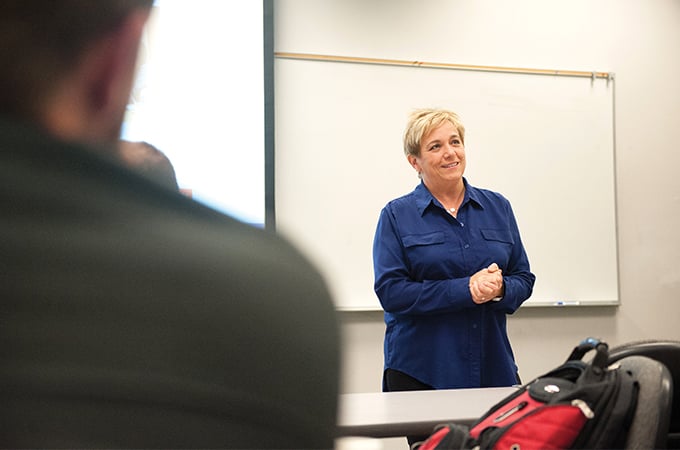“Presentations are about a speaker, an audience, and a message,” says School of Business Professor Allison Fraiberg, who is hosting a workshop that emphasizes the 21st century business skills of structuring and designing effective presentations.
Focused on conquering stage fright, designing compelling slides, and creating an impact, the workshop is structured around exercises and activities that improve the public speaking experience for both the speaker and audience. Free and open to students and alumni of the University of Redlands School of Business and School of Continuing Studies, the event is being repeated at the University’s Temecula, Burbank, and South Coast Metro campuses over the next three weeks.
During the September 13 workshop on the main Redlands campus, Fraiberg emphasized techniques that presenters can use before and during a presentation.
Since “presentations go haywire when the presenter gets surprised,” Fraiberg recommends that speakers familiarize themselves with the space in which they will be presenting, practice the presentation, and know their audiences. She also stressed the importance of knowing how to operate the technology in the presentation space and of being able to adapt if the location of the presentation changes.
Another helpful tip, Fraiberg noted, is to provide answers to the “what if” questions. “What if your slides don’t work?,” she said. “You need to answer that question. This practice reduces presentation anxiety. If you’re going to play the what if game, you have to play the answer game, too.”
Honing your message is also an important part of presentation preparation. In order for people to want to listen to a presentation, they have to care about what is being said. Because of this, Fraiberg said, part of the presentation must articulate what is at stake for the audience.
A speaker should focus less on why they need something to happen and much more on how their proposal will impact, even enhance, the experience of the audience. For example, if a manager wants to create opportunities for employees to work outside the office, they shouldn’t approach other managers by saying, “You need to let employees work off-site.” Instead, they should suggest, “Employee engagement increases by 25 percent when employees can manage their own work locations and schedules.”
Fraiberg also outlined three important tips to think about during a presentation:
- Face the audience. “No one wants to watch a presentation where the speaker is looking at the computer or projection screen.”
- Find a comfort space. “Focus on something in the room—it can be someone you know or an object—that can be something you look to during your presentation.”
- Forget your notes and talk. “Be conversational. It makes everyone more comfortable.”
For additional information on preparing presentations that deliver, Fraiberg recommends The Harvard Business Review Guide to Persuasive Presentations.
Learn more about the “Presentations that Deliver” workshop. Fraiberg is also offering a workshop titled “Secrets to Writing: Persuasive Reports, Proposals, and Research Proposals” at University of Redlands campuses.






